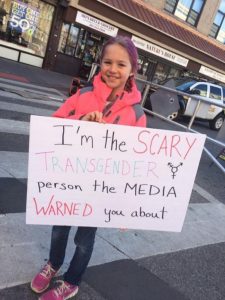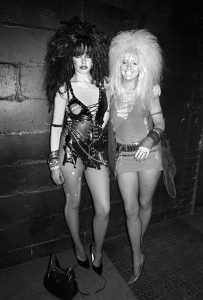Dina’s Diner – July 27, 2020
THE KIDS WERE RIGHT THE WHOLE TIME
 I came across an article that appeared over a year ago in The Atlantic magazine. Young Trans Children Know Who They Are by Ed Yong appeared on January 15, 2019.
I came across an article that appeared over a year ago in The Atlantic magazine. Young Trans Children Know Who They Are by Ed Yong appeared on January 15, 2019.
The article covers a study of trans children by University of Washington researcher Kristina Olson. The relatively recent phenomenon of young children self-identifying as trans is something I’ve written about several times here in the Diner. The research study helps to correct some misconceptions about these children (and parents) and outcomes of the transition stories. Olson began studying the health and well-being of gender nonconforming children in 2013. As she kept track of her subjects she realized she had a data set of 85 children covering several years of behavior. Some of the gender nonconforming kids went on to transition while others did not. “Her team has now shown, in two separate ways, that those who go on to transition do so because they already have a strong sense of their identity.”
The article reports: “There’s a lot of public writing focused on the idea that we have no idea which of these gender-nonconforming kids will or will not eventually identify as trans,” says Olson. And if only small proportions do, as some studies have suggested, the argument goes that “they shouldn’t be transitioning.” She disputes that idea. “Our study suggests that it’s not random,” she says. “We can’t say this kid will be trans and this one won’t be, but it’s not that we have no idea!”
Although it seems intuitive, the findings suggest that the children with the strongest identification with the opposite gender are more likely to transition. Some observers have suggested that parental or therapist “encouragement” may affect the child’s choice. The study found that some gender nonconforming children identified with the opposite gender as strongly as cis-gender children did with their birth genders. The self-identification with the opposite gender is not influenced by outside factors (like parents or therapists) because it comes from the inside out.
Charlotte Tate, a researcher at San Francisco University said, “There really is something distinctive and different about the kids who eventually go on to transition. From interviews with trans people, “one of the most consistent themes is that at some early point, sometimes as early as age 3 to 5, there’s this feeling that the individual is part of another gender group. When told that they’re part of their assigned gender, “they’ll say, ‘No, that’s not right. That doesn’t fit me.’ They have self-knowledge that’s private and that they’re trying to communicate.”
I have to admit that I’ve been skeptical about these early transition stories that keep occurring. I’ve mentioned that several times in writing about them over the years. If the study results are valid (and there’s no reason to doubt it), even the youngest trans kids may be communicating an instinctual truth about themselves that deserves to be respected.
DID YOU SAY FEMALE HUSBANDS?
I saw a review of a book titled Female Husbands: a Trans History in the July 10, 2020 online edition of the U.K.’s The Guardian. The book by historian Jen Manion uncovers stories of women who lived as men, including as husbands to other women. The interesting angle is that the instances that Manion recounts happened in the 1700s and 1800s when that sort of thing was very unusual indeed.
 The Guardian review reports about the book, “It comprises dozens of anecdotes and narratives, primarily drawn from newspapers detailing the lives of people who were considered girls at birth, but who adopted masculine names and appearances and who loved and lived with people Manion cheekily calls “female wives.”” Here are some brief setups from the review: “James Howe, an 18th-century publican and businessman, [born female as Mary East] who served his customers with ale and bonhomie while his wife did most of the housework.” Another: “George Johnson, a whaler and Massachusetts manufacturing worker, was described in an 1856 news clipping as “a male girl” and claimed to have “pretended to be a nice young man of 17, smoked strong cigars, [and] was a successful beau among the young ladies.” And this: “Consider Frank Dubois, who left a husband and two children in Illinois for a wife in Wisconsin. The authorities instructed Dubois to dissolve the latter marriage and reconvene the former. An article on the subject, headlined “Frank Dubois a Woman”, was published in the New York Times on 2 November 1883, in which a scandalised reporter exclaimed: “You insist that you are a man?” prompting Dubois to reply, resplendently: “I do; I am. As long as my wife is satisfied, it’s nobody’s business.”
The Guardian review reports about the book, “It comprises dozens of anecdotes and narratives, primarily drawn from newspapers detailing the lives of people who were considered girls at birth, but who adopted masculine names and appearances and who loved and lived with people Manion cheekily calls “female wives.”” Here are some brief setups from the review: “James Howe, an 18th-century publican and businessman, [born female as Mary East] who served his customers with ale and bonhomie while his wife did most of the housework.” Another: “George Johnson, a whaler and Massachusetts manufacturing worker, was described in an 1856 news clipping as “a male girl” and claimed to have “pretended to be a nice young man of 17, smoked strong cigars, [and] was a successful beau among the young ladies.” And this: “Consider Frank Dubois, who left a husband and two children in Illinois for a wife in Wisconsin. The authorities instructed Dubois to dissolve the latter marriage and reconvene the former. An article on the subject, headlined “Frank Dubois a Woman”, was published in the New York Times on 2 November 1883, in which a scandalised reporter exclaimed: “You insist that you are a man?” prompting Dubois to reply, resplendently: “I do; I am. As long as my wife is satisfied, it’s nobody’s business.”
Manion’s book was perhaps inspired by two books published long before modern concepts of gender expression evolved. The Male and Female Husband was a fictional tale of an intersex person published in 1682. Henry Fielding’s 1746 novel The Female Husband was a fictionalized version of the life of Charles (born Mary) Hamilton who ran away from home to live as a boy, eventually married a woman and was later arrested.
Surprising to me, the review included excerpts of newspaper reports of the cases and the matter-of-fact manner in which it was reported. Perhaps people of those eras were more attuned to this sort of thing than I gave them credit for.
BEAUTY IS DESTINY
I saw a photo from a Filipino television series that starred actor Ken Chan as a trans beauty named Destiny Rose – which was also the name of the series. I was taken aback by the photo because in full drag, Ken Chan looked like a natural beauty. In many of the instances where actors are placed in crossdressed situations, the effect is always slightly skewed — as if they want the audience to know that the actor is not really into dressing like a woman. Heaven forbid.
Destiny Rose only ran on Filipino TV for one season in 2015-2016 so it’s a bit of old news but chances are most of us haven’t heard of it before. It actually ran in an afternoon time slot so I am assuming it was a soap opera format. Ken Chan plays Joey Vergara who wants to transition and become a woman novelist. So it’s a serious storyline, not a comic gender-bending laff riot. It looks like you might be able to view episodes on YouTube or the GMA webpage linked above.
Ken Chan is not trans and has enjoyed a professional acting career before and since the Destiny Rose series. I’d love to hear how he felt about his cosmetic transformation and what kind of reactions he got when people saw how gorgeous he looked. I couldn’t find any interviews with him about the show.
I suppose this series couldn’t be duplicated today (casting a crossdressed actor) because some people would insist that the role go to a true trans actor. I have a feeling that American network television would screw it up somehow anyway. (Editor’s Note: You can read a short interview with Chan on Startattle.)
HOMELY SEXINESS AND MASKS REVISITED
I get a lot of unsolicited suggestions on my Pinterest and Instagram feeds. Mostly a lot of photos of women in scanty dress. I’m not complaining, mind you. I guess I just hate to be that predictable to an algorithm.
One recent Instagrammer who kept popping onto my search suggestions was a woman going by the name Chloe_B_Chloe. I found her fetching because she fell into the category I would call “homely sexy.” Don’t get me wrong. I think Chloe is smoking hot but she is not your classic pinup model. What I like about her is her sense of personal style — always in skyscraper heels, very short hemlines, sometimes eyeglasses, sometimes lingerie. She has a warm friendly smile, not leering, or trying to look seductive. She could be the young lady next door or in the supermarket or wherever. You would never guess she is (I suppose) making some kind of living as an Instagram pinup model.
I wrote about “homely sexy” women in The Diner before and it was only a little over a year ago, June 3, 2019. Some concepts never go out of style.
In the same June 3, 2019 Diner, I also had an item about celebrity face masks. I forgot about that when I wrote last month about Covid-19 face masks. Last year’s item pre-dated the current virus outbreak, of course. At the time, celebrities (Kendall Jenner, Miley Cyrus, K-Pop bands, and others) wearing designer surgical masks as a sort of fashion statement seemed downright kooky. Who’s laughing now?
2 FROM ‘86
The accompanying photo was found on the internet during a browse. The caption on the link said it was two club goers at the Asylum Club in London in 1986. The two women are unidentified and — sadly — unknown. The photographer is Derek Ridgers, who I found out was well-known as a chronicler of London’s underground and punk scene in the 1970s and ‘80s.
The photo resonates with me because it coincides with the era when I started to crossdress seriously, which happened during the mid-1980s. The combination of exotic eye makeup, torn fishnets, vinyl dresses, gigantic hair, and high heels is still iconic in my mind.
I never assume my feelings about crossdressing are universal. Everyone has their own taste, triggers, or inspirations for dressing. In this case, the idea of looking that hot and going out dressed like that was the kind of psychic fuel that inspired me back in the day even if it never really came to pass in quite that way. I wonder how you feel about it. I’m partial to the girl in black on the left. If she was in her early twenties in 1986, she would be around 55 years old now.
What are you doing now, unknown, daring, darling? “Eating chips and watching the telly, you silly bugger.”
Like to make a comment? Login here and use the comment area below.
Category: Transgender Fun & Entertainment, Transgender Opinion






